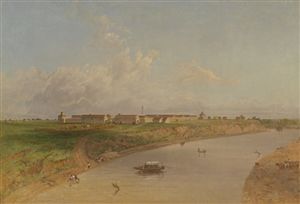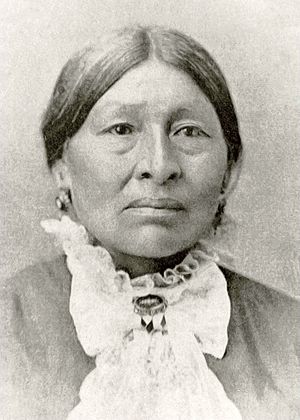Fort Rice facts for kids
Fort Rice (Lakota: Psíŋ Otȟúŋwahe; "Wild Rice Village") was a frontier military fort in the 19th century named for American Civil War General James Clay Rice in what was then Dakota Territory and what is now North Dakota. The 50th Wisconsin Infantry Regiment became the garrison in October 1865.
Contents
Foundation and History
The fort was originally established in 1864 by General Alfred H. Sully and was built by him and the 30th Wisconsin Infantry Regiment. This regiment would later be replaced by the 1st US volunteer infantry, consisting mainly of ex-confederate soldiers who had joined the Union. Its location was placed north of the mouth of Cannonball River, and south of Heart River's mouth. The buildings within the fort were made of materials that could be found locally, including cottonwood logs for walls and support, and prairie sod for roofing. The fort was reconstructed in 1868, with the old buildings being torn down and new ones constructed in their stead. The fort became a quadrangle with dimensions of 864 by 544 feet, with 10 foot high wooden barriers surrounding it. By the renovations' completion in 1875, the fort consisted of a guardhouse, a library, a bakery, a magazine, a hospital, four company quarters, five storehouse, and seven officer buildings.
The State Historical Society of North Dakota protects the fort area as Fort Rice State Historic Site, located about 30 miles south of Mandan, North Dakota in Morton County. Visitors can see depressions, foundation lines, and WPA corner markers for the original buildings. The site has a marker indicating the historical significance of the area.
Usage
Despite the protests of its location, Fort Rice sometimes served as a connecting point between the people of the United States and Sioux Nation. Meetings were held and treaties were signed on its premises. Though tensions remained high for the entire duration of the fort's usage, it served as an invaluable outpost in the frontier for the US government. Expeditions were led from the fort for exploratory purposes, and having a military presence nearby meant that travelers, railway surveyors, and workmen were safe from ambushes from indigenous peoples and wildlife.
Notable Events and People
The First Winter
During the first winter at the fort, the garrisoning company suffered great losses. 81 men lost their lives, mostly due to scurvy as a result of malnutrition. Seven of these 81 deaths were a result of attacks from the Lakota tribesmen, who believed that the land that the fort situated itself on was rightfully belonged to their people. This belief held true, as the construction of a fort on the land that Fort Rice sits on was a direct violation of the Treaty of Fort Laramie (1851), and leaders of local Lakota tribes demanded the removal of the fort. Prominent Sioux leaders such as Sitting Bull even led attacks against the fort's supplies and livestock in hopes of making the garrisoned army abandon the fort.
Treaty of Fort Laramie of 1868
The Treaty of Fort Laramie (1868) served as a victory in the Oglala, Miniconjou, and Brulé tribes of the Lakota people reclaiming a decently large portion of their land. It followed the failed Treaty of Fort Laramie (1851), but was much more successful in both parties holding true to their claims. Upwards of 50,000 Sioux gather at Fort Rice for the signing of the treaty, with notable leaders including Running Antelope and Two Bears attending. Sitting Bull did not attend, but sent a replacement to sign the treaty in his stead.
Sitting Bull
The Sioux leader Sitting Bull was strongly in favor of the independence of his own people, and was notorious for refusing peace offerings from the US government. At one point, Sitting Bull roused an army of upwards of 400 warriors to attack Fort Rice. After a three hour battle, about a dozen Lakota warriors were killed, with two US soldiers killed and three wounded. This failed attempt to ravage the fort's defenses cost Sitting Bull a decent amount of reputation and honor among his people.
Matilda Galpin (Eagle Woman That All Look At)
Rain-in-the-Face
1953 Tornado



